ePEG™
SIP’s ePEG algorithm accurately attenuates free surface pegleg multiples, in a variety of water depths, regardless of offsets and sampling technique.
Traditional industry SRME approaches are limited by water depth, offsets and sampling, and the workflow is long and tedious.
ePEG is not limited by water depth, offsets or sampling and has demonstrated superior wells ties leading to more robust wavelets and improved elastic inversion.
ePEG is complimentary to eSRME and the processing route is simple and elegant. SIP modified the eSRME approach to deliver a combined unified theory of de-multiple, using modelling and adaptive, non-stationary subtractive techniques, where the multiples model is a combination of all orders of free surface peg-legs and internal peg-legs.
The ePEG algorithm preserves amplitudes and removes more multiples from the datasets without destroying primary energy. This yields gathers with higher signal to noise and a cleaner migration and means that amplitudes are preserved for rock properties and inversion.
When compared to the traditional industry contractor 9 step workflow, ePEG takes only a fraction of the time and there is no further requirement for TP-Decon or XT-Decon.
Using ePEG massively reduces the turnaround time of projects and obtains far more accurate results.

